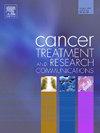Effect of hypoxia on extracellular vesicles in malignant and non-malignant conditions
IF 2.4
Q3 Medicine
引用次数: 0
Abstract
Extracellular vesicles (EVs) are produced by virtually all types of cells and can be detected in nearly all extracellular places. These particles mediate intercellular communication and transfer their cargo to the recipient cells, inducing a variety of processes in these cells through transmission of several biomolecules such as miRNAs, lncRNAs, other transcripts and a variety of proteins. It has been documented that size, quantity, and expression of biomolecules in the EVs are influenced by the level of oxygen. In fact, hypoxia can affect several cellular processes through modulation of the cargo of these vesicles. Hypoxic exosomes derived from tumor cells have several protumoral effects on the recipient cells, including enhancement of proliferation, migration, and invasion in other tumoral cells, induction of metastasis in distant organs, stimulation of angiogenesis in the endothelial cells, and modulation of macrophage polarization. Hypoxic EVs also contribute to several non-malignant diseases. This review summarizes the effect of hypoxia on EVs cargo in malignant and nonmalignant diseases of different organs.
缺氧对恶性和非恶性疾病细胞外囊泡的影响
几乎所有类型的细胞都会产生细胞外囊泡 (EV),而且几乎所有细胞外的地方都能检测到它们。这些颗粒介导细胞间通信,并将其货物转移到受体细胞,通过传递多种生物大分子,如 miRNA、lncRNA、其他转录本和多种蛋白质,诱导这些细胞的各种过程。有文献表明,EVs 中生物大分子的大小、数量和表达受氧气水平的影响。事实上,缺氧可通过调节这些囊泡中的货物影响多个细胞过程。来自肿瘤细胞的低氧外泌体对受体细胞有多种原发效应,包括增强其他肿瘤细胞的增殖、迁移和侵袭,诱导远处器官的转移,刺激内皮细胞的血管生成,以及调节巨噬细胞的极化。缺氧性 EVs 还可导致多种非恶性疾病。本综述总结了缺氧对不同器官恶性和非恶性疾病中 EVs 货物的影响。
本文章由计算机程序翻译,如有差异,请以英文原文为准。
求助全文
约1分钟内获得全文
求助全文
来源期刊

Cancer treatment and research communications
Medicine-Oncology
CiteScore
4.30
自引率
0.00%
发文量
148
审稿时长
56 days
期刊介绍:
Cancer Treatment and Research Communications is an international peer-reviewed publication dedicated to providing comprehensive basic, translational, and clinical oncology research. The journal is devoted to articles on detection, diagnosis, prevention, policy, and treatment of cancer and provides a global forum for the nurturing and development of future generations of oncology scientists. Cancer Treatment and Research Communications publishes comprehensive reviews and original studies describing various aspects of basic through clinical research of all tumor types. The journal also accepts clinical studies in oncology, with an emphasis on prospective early phase clinical trials. Specific areas of interest include basic, translational, and clinical research and mechanistic approaches; cancer biology; molecular carcinogenesis; genetics and genomics; stem cell and developmental biology; immunology; molecular and cellular oncology; systems biology; drug sensitivity and resistance; gene and antisense therapy; pathology, markers, and prognostic indicators; chemoprevention strategies; multimodality therapy; cancer policy; and integration of various approaches. Our mission is to be the premier source of relevant information through promoting excellence in research and facilitating the timely translation of that science to health care and clinical practice.
 求助内容:
求助内容: 应助结果提醒方式:
应助结果提醒方式:


